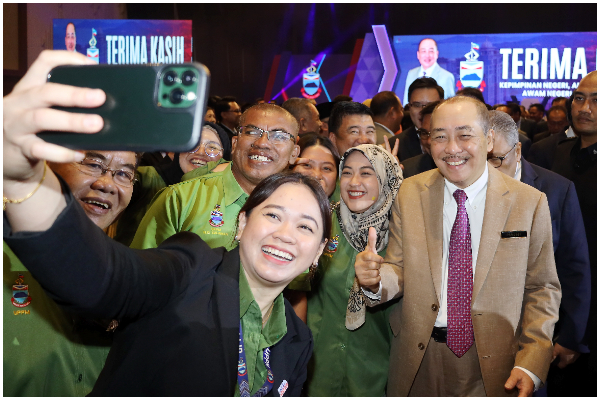Protecting Sabah’s water sources: Areas in seven districts with treatment plants to be gazetted first
Published on: Saturday, March 23, 2024
By: Larry Ralon
 “The conservation areas will be given some flexibility because they mostly involve titled lands and farms. But we have to make a policy for the conservation areas where we will have regulations for the use of land in the area,” Jeffrey said.
“The conservation areas will be given some flexibility because they mostly involve titled lands and farms. But we have to make a policy for the conservation areas where we will have regulations for the use of land in the area,” Jeffrey said.
Kota Kinabalu: The Sabah Water Council will propose to the State Government to gazette water source areas in every district, especially the seven districts that have water treatment plants.
As a protected area, chances are greater that the State’s water supply would be guaranteed during the dry season. The seven districts are Tuaran, Papar, Penampang, Tawau, Sandakan, Semporna and Kudat.
ADVERTISEMENT
Identified water catchment areas located outside water source areas would also be proposed for gazetting as a conservation area.
Deputy Chief Minister I Datuk Seri Dr Jeffrey Kitingan, who is also the Council’s Chairman, said this at a press conference after chairing its first meeting this year at Wisma Pertanian, Friday.
A protected area means areas cannot be disturbed at all even if they are State lands or outside forest reserves or national parks, while a conservation area would have regulations for the use of land in those areas.
“But so far we are still okay,” he said, adding Sabah is facing water supply problems because of the prolonged dry season, coupled with the El Nino phenomenon, and not because of water management problems.
ADVERTISEMENT
“The conservation areas will be given some flexibility because they mostly involve titled lands and farms. But we have to make a policy for the conservation areas where we will have regulations for the use of land in the area,” he said.
He added that these proposals are for the present and the long term which requires Sabah to take care of water resources to be used by the State Water Department for the use of the people and industries.
ADVERTISEMENT
The meeting also received other proposals to deal with drought issues such as finding water sources through tube wells, the implementation of water transfer methods (channelled via pipes or water tankers from an area that has sufficient water supply to another area that experienced water shortage) and coastal reserves.
“In future, when we face the monsoon season, we have to take that as an opportunity to collect flood water to be stored for use in the dry season.
“We will bring to the State Government for consideration the proposed coastal reserves, to store excess river water in the monsoon season. In addition, it is also necessary to create retention ponds in areas upstream of rivers so that flood water can be reduced in the downstream areas.
“Coastal reserves will be like retention ponds, where excess river water will be channelled to and stored. We will study how this can be done. We also have to consider creating retention ponds in areas where they are needed.”
Dr Jeffrey said the most important thing is to give understanding to the people of Sabah to preserve the environment and rivers and practice conservation.
“Some suggested that the Village Development and Security Committees (JKKK) might need to have a sub-committee for looking after and conserving water source area,” he added.
Dr Jeffrey said Irrigation and Drainage Department (DID) data showed river levels in Sabah have dropped from 10 per cent to almost 50 per cent of the normal level.
The water level in Babagon Dam has dropped by 31 per cent from the normal level but the situation is still under control and it can sufficiently supply to the treatment plant.
He said so far, the State Water Department data showed six water plants are experiencing water supply disruptions in Sabah.
They are Nabalu Pekan Water Plant in Tuaran, the Emergency Water Supply Scheme (EWSS) Water Treatment Plant in Papar, the Water Plant in Sebatik Island (empty because the water reservoir has dried up due to the prolonged drought), Jalan Utara Hilltop Water Treatment Plant in Sandakan, Sungai Intan Water Treatment Plant in Semporna and Water Plant in Pulau Banggi, Kudat.
“Most of the critical incidents are on islands like Sebatik and Banggi.”
Dr Jeffrey, who is also the Agriculture, Fisheries and Food Industry Minister, said that the decreasing river water level may also affect food production in the State, especially rice.
Paddy cultivation areas affected are Papar, Kota Belud, Tambunan, Membakut and Keningau.
He said in Kota Belud, it involved 267 acres, while in Papar 135.12 acres, Keningau 5,621.65 acres and in Membakut 99 acres.
“Fortunately, some of them are already in the harvesting level. What I am worried about is for planting in the coming season.
“We have to use mobile pumps but it involves cost, like in Tambunan we use water taken from Sungai Pegalan. Usually, irrigation uses gravity water,” he said.
To another question, desalination technology (using sea water) is already available but the State has not activated that need at the moment, as well as cloud seeding which the Government is considering.
Stay up-to-date by following Daily Express’s Telegram channel.
Daily Express Malaysia










